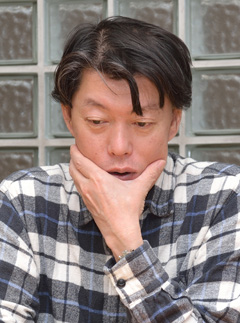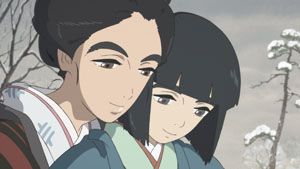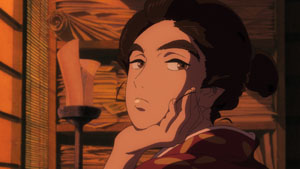Interview with Keiichi Hara
 |
Keiichi Hara Born in Tatebayashi, Gunma Prefecture, in 1959, Hara worked extensively on popular family and children TV animated shows, such as Doraemon and especially Crayon Shin-chan, for which he initially served as episodic director under Mitsuru Hongo from 1992, and later as series director from 1996 to 2004. He also scripted ten Crayon Shin-chan movies, directing six. The 2001 Shin-chan franchise movie, entitled Crayon Shin-chan: Impetuous! The Adult Empire Strikes Back earned wide critical praise, and raised his profile. The following year's Crayon Shin-chan: Brilliant! The Great Battle of the Warring States was recommended by the Agency for Cultural Affairs and won five awards in Japan. Hara then shifted to independent filmmaking, pursuing more personal projects. International recognition came with Japan Academy Prize-winning Summer Days with Coo (2007) and especially with Colorful (2010), greeted with the Jury's Special Distinction and the Audience Award at Annecy 2011. Hara admires classic Japanese filmmakers such as Yasujiro Ozu and Keisuke Kinoshita. To the latter, he dedicated his first live-action movie in 2013, Dawn of a Filmmaker: The Keisuke Kinoshita Story. His latest animated film, Miss Hokusai (2015) won prestigious international awards at Annecy, Fantasia, Sitges and APSA, and was described by French newspaper Le Monde as "a lesson of elegance". |
This film is based on the original manga Sarusuberi (Crape Myrtle) by Hinako Sugiura. Could you describe which aspects of the original story were more attractive to you?
HARA As a matter of fact, I love all Sugiura's works, and Sarusuberi in particular. When I was working on Summer Days with Coo, there was this scene with a huge dragon flying in the night sky near Tokyo Tower. I recall bringing to the staff a page from Sarusuberi, and tell them: this is how I want it to be done! This is why this movie is a dream come true. And it was a lot of pressure, too, as I really loved this manga: it portrays reality but it is visionary, it touches dramatic and humorous aspects of life, still the supernatural is always lurking behind the thin veil of reality. With such wonderful material, I felt I could make it into a visually entertaining movie. Period dramas tend to be overly stylish, and yet Sugiura succeeds in delivering both a realistic historical rendering, and convincing, lively characters. This film is a story about people, rather than a biopic. We did our research, as I must confess I was certainly not an expert in the Edo period, but Miss Hokusai is basically an adaptation of Sugiura's comic and worldview.
What did you keep from, and what did you add to the original comic book?
HARA Sugiura's comic is a collection of short stories without any actual continuity among each other. Furthermore, each story focuses on a different character. The titular crape myrtle is a reference to Hokusai, but there's no real protagonist, as Zenjiro is prominently featured, and O-Ei becomes more and more important as the series progresses. So I decided to focus on O-Ei, who is arguably Sugiura's avatar inside the comic book, and I developed the character of her little sister, O-Nao, who in the comic appears only in the last story, still one of the most beautifully touching, and actually the core around which I built this movie. I used "family" as the cohesive agent to create a movie which could stand on its feet. In collaboration with scriptwriter Miho Maruo, we also added two entirely original episodes, namely the scene on the bridge with O-Ei, O-Nao and Hatsugoro, and the snow sequence in the middle of the film. The ending is original, too.

Is there any major difference between the movies you directed so far and Miss Hokusai?
HARA I think it is the first time in years I have made a movie where nobody cries. Again, I believe this is one of the peculiarities of Sugiura's storytelling. Never melodramatic, never overdone. I would call it "dry." Still, her stories convey great emotions. This is what I admire in her style and I am trying to emulate. If you think she wrote this when she was 24, you can only call her a genius.
Hokusai and O-Ei: who between these two proved easier to render? And who is your favourite character in the film?
HARA O-Ei was easier to work on of course. While being a historical character, unlike her father we don't really know much about her, and this gave me leverage in developing her personality, although I owe much to the source material. O-Ei feels in rivalry with her father, who also happens to be her master as an artist. She's proud, strong-willed to stubbornness, and overall a rather self-assertive person. Still, she's terribly shy and clumsy when it comes to her unspoken romantic interest. And she's as sweet and protective as a mother to her little sister, O-Nao. So I thought I could offer a complete portrayal of this incredibly intriguing woman by showing the many sides of her personality, and make effective use of the changing seasons to tell a story throughout a one-year span. As for my favourite character... I'd say Zenjiro. He's the most "human" of the whole lot.

The music score for this movie is quite interesting and unexpected.
HARA I had discovered from Sugiura's brother that she used to draw her comics while listening to rock music. It was indeed a very unconventional association, and I decided to pay homage to this unique creative process, so I had O-Ei walk the streets of 1814 Edo at the sound of electric guitars. It was a decision I took at a very early stage, because it is also a way to inform the audience that what they are going to watch is not your typical period drama. And if you allow me to say it, O-Ei rocks.
What image do you have of Hokusai?
HARA Today he is celebrated as one of Japan's greatest artists, and he is probably considered such at world level. However, when he was alive he was rather seen as a talented yet bizarre craftsman, a commoner among commoners. Ukiyo-e prints required cooperation among specialised artisans, and to this extent it is very similar to animation today. I certainly don't have the creative power of Hokusai, but I would like to consider myself as an artisan, who collaborates with many other people possessing different skills in order to achieve the end result.
Miss Hokusai is a film that defies classifications. One would be tempted to say it is about nothing, and about everything at the same time, hiding its deepest sensitiveness behind what at first look seems a disjointed succession of episodic stories. A French journalist acutely wrote that Miss Hokusai "touches everything and speaks about everything, and still falls on its feet with almost sublime grace." How would you describe the spirit of your film? What would you like audiences to make of it?
HARA Sugiura set most of her stories in the Edo period. People back then favoured an attitude to life they called iki. Being smart and stylish while remaining simple and spontaneous, was considered savoir vivre. The opposite to this concept was yabo, or being self-centered and greedy, pretentious and showy, and obsessed with money and material things. Therefore, literature and art of the Edo period were conceived under this iki aesthetics. Authors rejected being too straightforward about meanings or conclusions, this being regarded as utterly yabo, or unsophisticated. To me Sugiura was iki, and this showed throughout her entire work. So I attempted to bring the same spirit into this film as well. Miss Hokusai, like the source material it is based upon, doesn't have a linear story, but encompasses the whole spectrum of human feelings. Like you would not expect photorealism from impressionist painting, it makes sense in the sum of its apparently disconnected parts, because our lives are a random sequence following an unscripted path. In the end, it's about the beauty and suffering of being alive. I would like each one who is going to watch this film to find their own meaning -if any at all. Because the answers we find belong only to ourselves.
© 2014-2015 Hinako Sugiura•MS.HS / Sarusuberi Film Partners

![WORK LIST[DETAILS]](/contents/works/design/images/left_title.gif)



 terms of use
terms of use